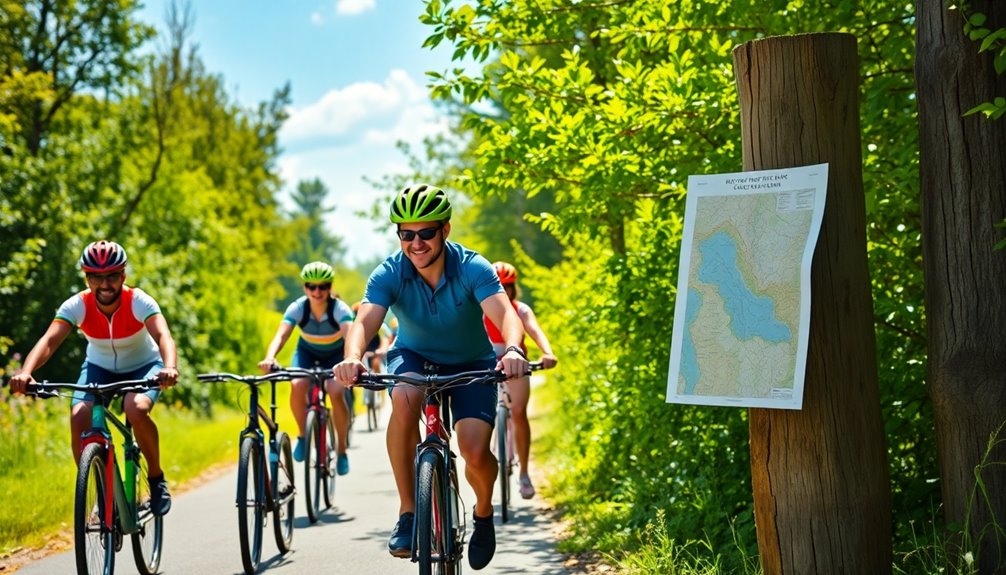As a beginner in cycle tourism, you'll face challenges like route planning, physical endurance, and safety. Start by selecting scenic, low-traffic routes, and don't hesitate to join local tours to build confidence. Utilize apps like Ride with GPS for detailed route planning. Pack essential gear like a helmet, lock, and spare tubes. Emphasizing safety and engagement with local cultures can enhance your experience. Keep moving forward; more tips await to help you navigate your journey.
Key Takeaways
- Start with well-planned routes that prioritize safety, amenities, and scenic views to enhance your cycling experience.
- Build confidence by joining local cycling tours or events to familiarize yourself with cycling infrastructure and meet fellow cyclists.
- Invest in essential safety gear and equipment, such as a quality helmet, bike lock, and navigation tools, to ensure a secure ride.
- Embrace gradual training, incorporating base workouts and intervals to improve endurance and energy levels for longer cycling trips.
- Engage with local communities and support businesses to enrich your cultural experience while promoting sustainable tourism practices.
Understanding Route Selection for Beginners
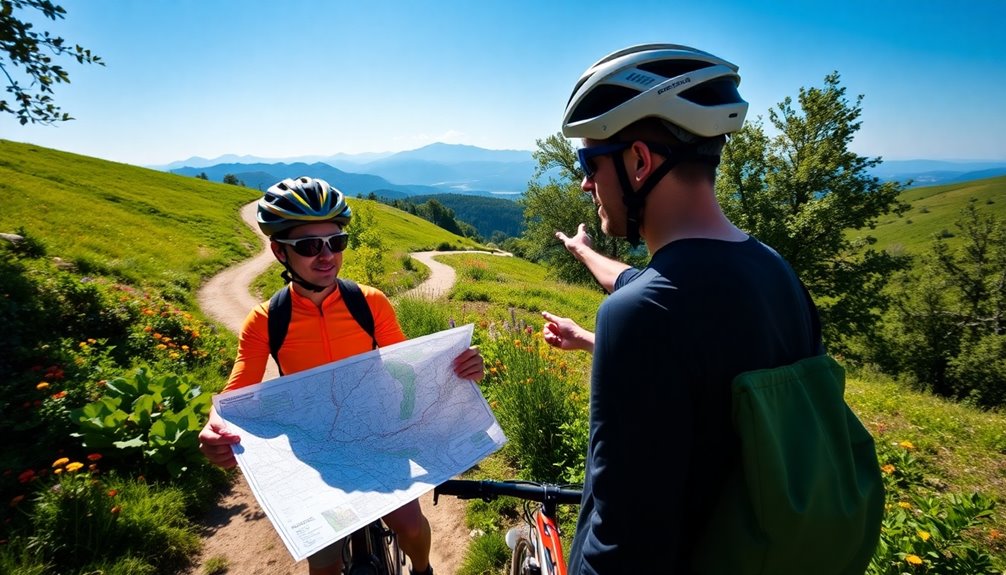
When you're planning your first cycling adventure, how do you choose the right route? Start by considering the terrain; flat routes are perfect for beginners, minimizing fatigue and leg pain.
Limit your daily cycling to around 50 km to keep the experience enjoyable and safe. Look for routes with well-marked signs and nearby amenities like bike shops and campsites.
Don't forget to prioritize safety—choose paths with low traffic and dedicated cycling lanes. Scenic value matters too; opt for routes that showcase picturesque landscapes and cultural landmarks. Additionally, consider routes with low input lag for a smooth cycling experience without unexpected interruptions.
For added reliability, check out the EuroVelo network, which offers certified routes with quality infrastructure.
With a bit of research, you'll find a route that suits your cycling adventure perfectly!
Building Confidence With Local Tours
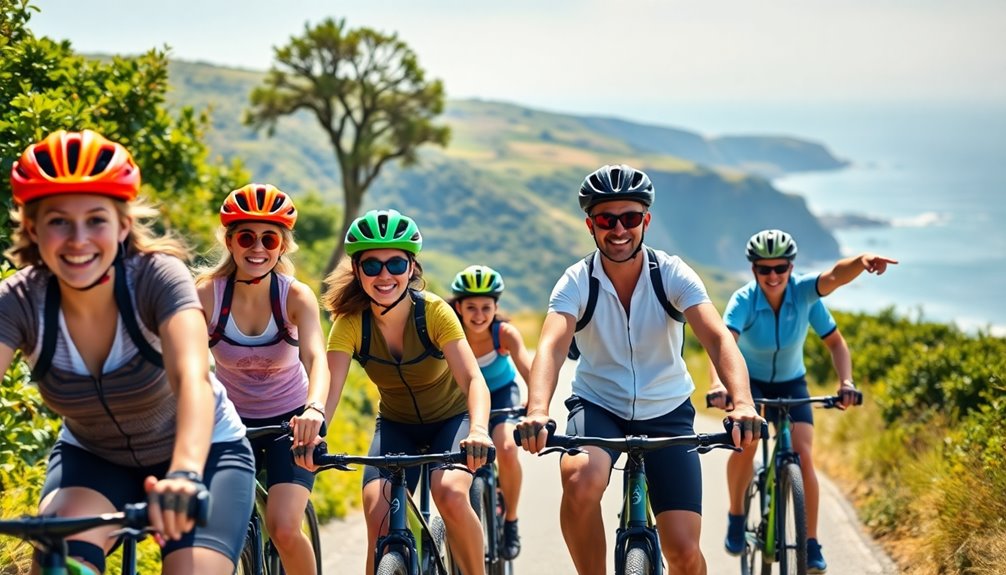
Building confidence through local tours can transform your cycling experience from daunting to exhilarating. When you join a local cycling tour, you not only explore new routes but also connect with the community.
These tours often promote sustainable practices and contribute to the local economy, making you feel good about your choice. Participating in local cycling events boosts your confidence and helps you meet fellow cyclists, creating a supportive network.
With professional guidance and safety measures in place, you'll gain valuable skills and knowledge. Plus, you'll become familiar with local cycling infrastructure, making future rides less intimidating.
Embrace these opportunities, and you'll find your cycling journey becomes more enjoyable and fulfilling.
Effective Use of Route Planning Tools
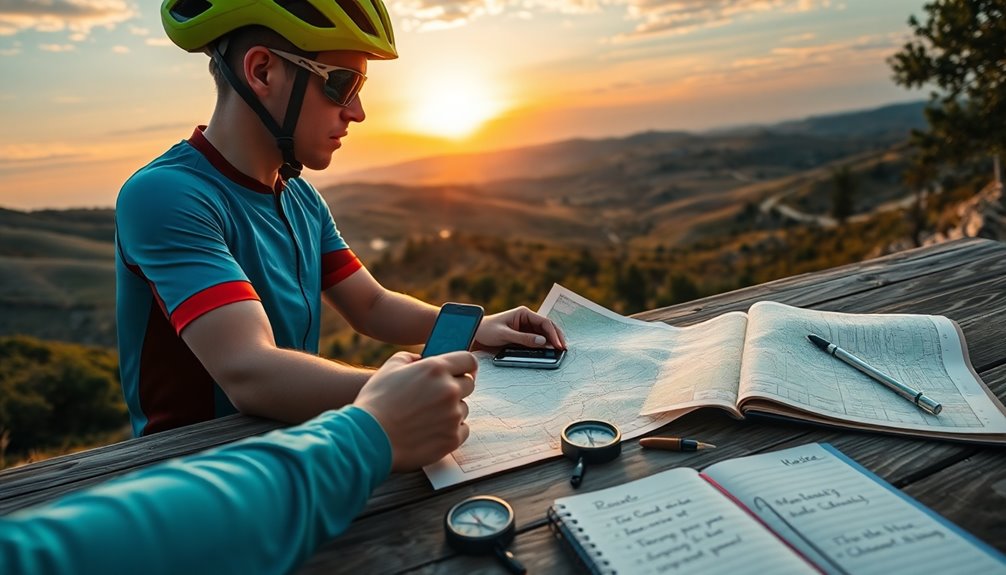
Effective route planning can make all the difference in your cycling adventures, ensuring you enjoy every moment on the road.
Utilize tools like Ride with GPS for multi-day planning and customizable routes, or Komoot for detailed elevation profiles and offline navigation. These platforms allow you to assess terrain, choose the best cycling modes, and avoid unsafe roads.
Plotaroute's sophisticated route profiles and Google Street View help you visualize your journey. Remember to sync your routes with devices like Wahoo or Garmin for seamless navigation. Additionally, consider your risk tolerance when planning challenging routes, as this can impact your overall enjoyment and safety on the ride.
Budgeting for Your Cycle Tour
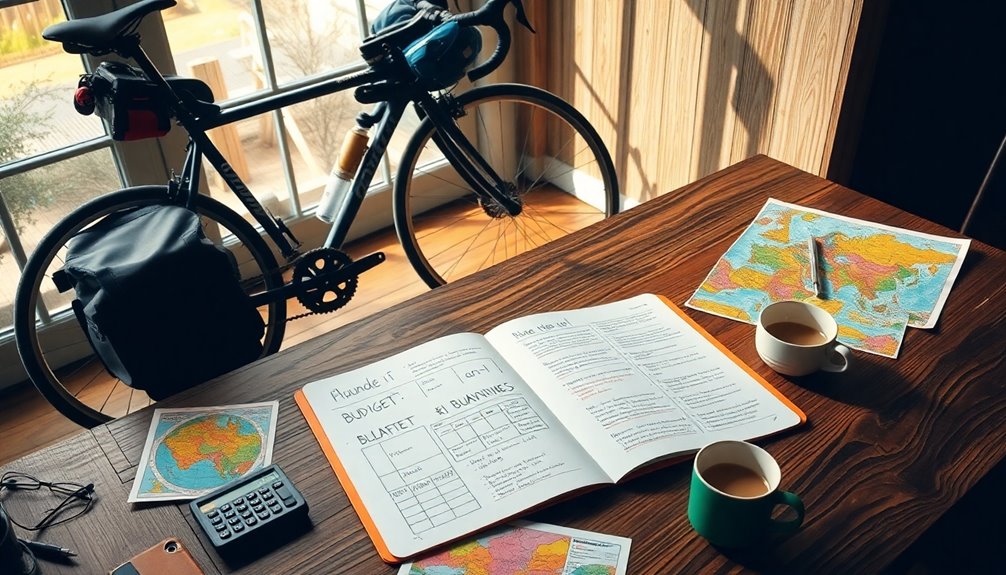
Budgeting for your cycle tour is crucial to ensuring a smooth and enjoyable experience on the road. Start by estimating your daily budget, aiming for $15-$25 per person, and allocate funds for accommodation, food, and transportation.
Opt for budget hotels, hostels, or even wild camping to cut costs. Cooking your meals instead of dining out can save you a lot, too. Consider traveling with a friend to share expenses.
Use budgeting apps or spreadsheets to keep track of your spending, and set aside emergency funds for unexpected costs. Remember, planning for attractions and post-tour expenses is just as important. Additionally, implementing the 50/30/20 rule can help you allocate your budget effectively across different categories.
Preparing Physically for Longer Rides
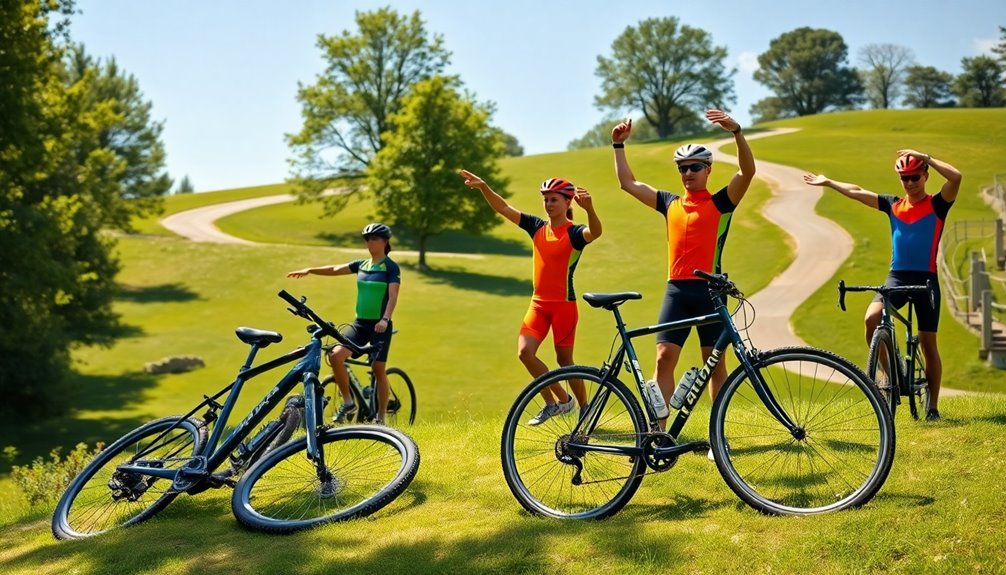
As you prepare for longer rides, it's essential to focus on gradually increasing your distance to build endurance without risking injury. Start by adding 10-30 minutes to your ride each session.
Prioritize aerobic training, spending about 80% of your time in zone 2 to improve cardiovascular endurance. To enhance muscle endurance, incorporate high-intensity intervals for 20% of your training.
Don't forget strength training to boost core stability and prevent injuries. Include long rides, beginning with three hours, and gradually extend your duration.
Mix terrains and add hill sessions for varied challenges. Lastly, ensure you have adequate rest and recovery, along with proper nutrition post-ride, to replenish your energy stores effectively. Additionally, consider using a hybrid bike to benefit from its versatility and comfort during your training.
Ensuring Safety and Security on the Road
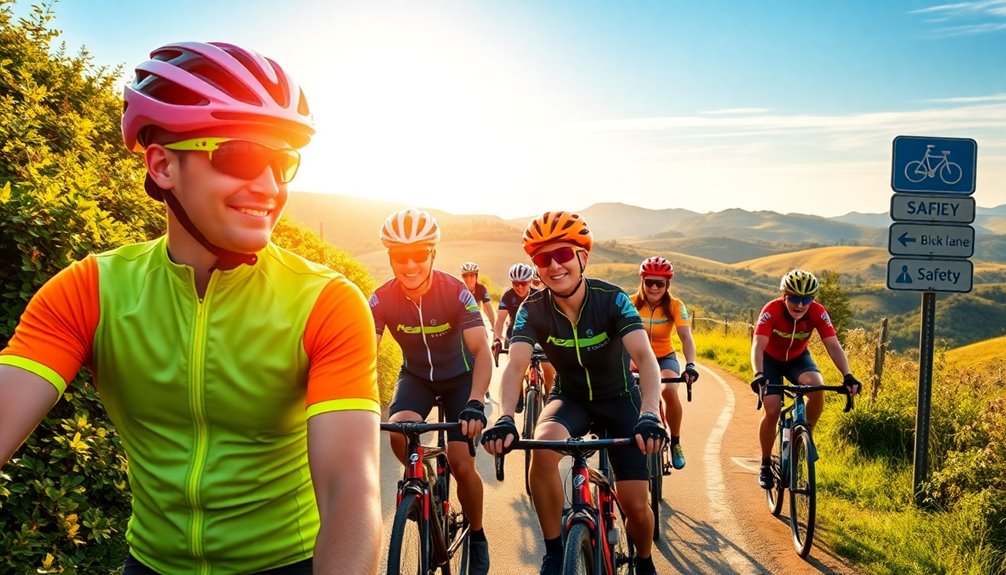
While you're excited to hit the road, ensuring your safety and security should be a top priority. Start by wearing protective gear like helmets and eye protection. Avoid distractions by leaving headphones behind, so you can hear your surroundings. Keep visibility high with bright clothing and lights, especially in low-light conditions. Always obey traffic laws to stay safe and legal. Choose less busy routes, and stay aware of potential hazards like potholes. Use hand signals to communicate with drivers and navigate intersections cautiously. Secure your bike with quality locks in well-lit areas, and always remove valuable accessories when leaving it unattended. Finally, carry emergency information and familiarize yourself with local cycling regulations. Additionally, ensure your gear is regularly inspected and maintained to enhance performance and reduce injury risks while cycling, especially with proper fit and comfort.
Essential Equipment and Gear for Cyclists
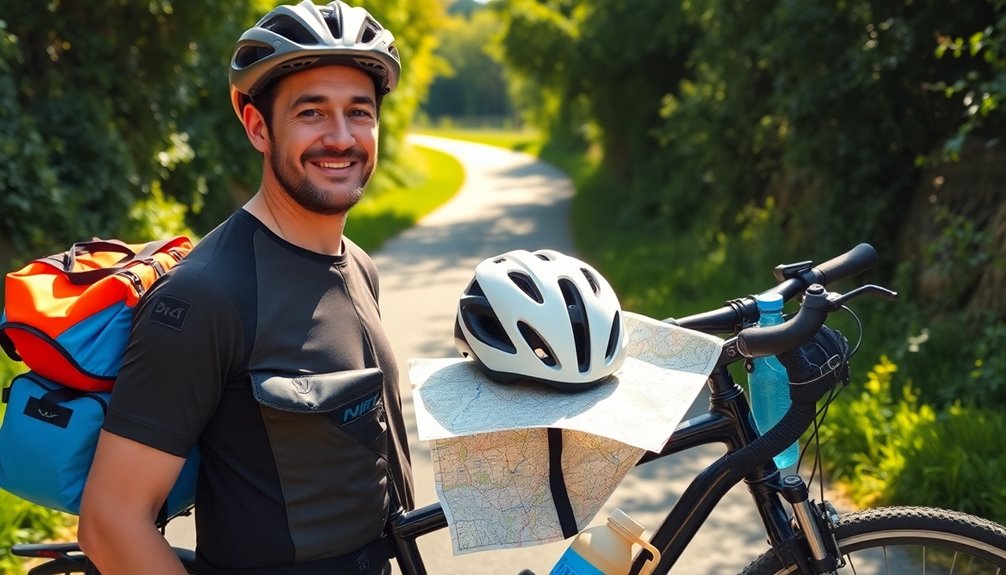
Once you've taken steps to ensure your safety on the road, it's time to consider the equipment and gear that will enhance your cycling experience.
Start with a quality helmet for head protection and a hydration system to stay refreshed. A bike lock secures your ride when you're away, while a spare tube and tire levers, along with a pump or CO2 inflator, prepare you for flat tires.
Don't forget comfort and protection: cycling gloves, padded shorts, and specialized shoes improve your ride.
Sunglasses shield your eyes, and arm and leg warmers adapt to changing weather. For navigation, a cycling computer, phone holder, and road lights keep you safe and on track.
Lastly, a multi-tool and patch kit ensure you're ready for repairs. Additionally, consider establishing an emergency fund to manage unexpected expenses related to your cycling adventures.
Choosing Between Guided and Self-Guided Tours
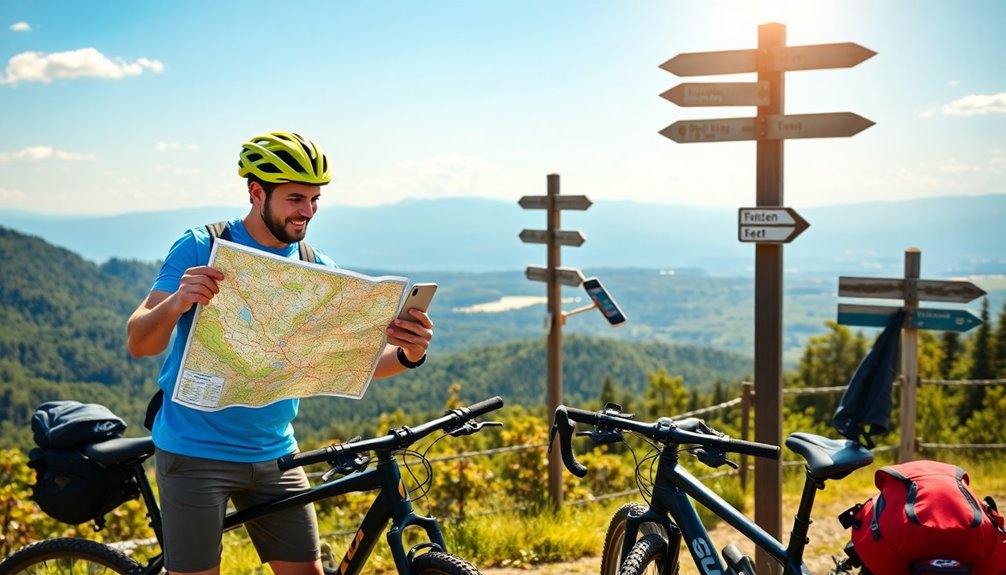
Which type of cycling tour suits you best: guided or self-guided?
Guided tours provide structure with a knowledgeable guide and support vehicle, making it easier if you prefer companionship and assistance. You'll enjoy planned activities, meals, and the chance to meet new people, but these tours often come at a higher cost.
On the other hand, self-guided tours offer flexibility and independence, allowing you to travel at your own pace. While they typically cost less, you'll rely on maps and hotline support for navigation and emergencies.
Consider how much structure you want, your budget, and if you enjoy socializing with others. Each option has its perks, so choose what aligns with your preferences!
Health and Fitness Considerations for Cyclists
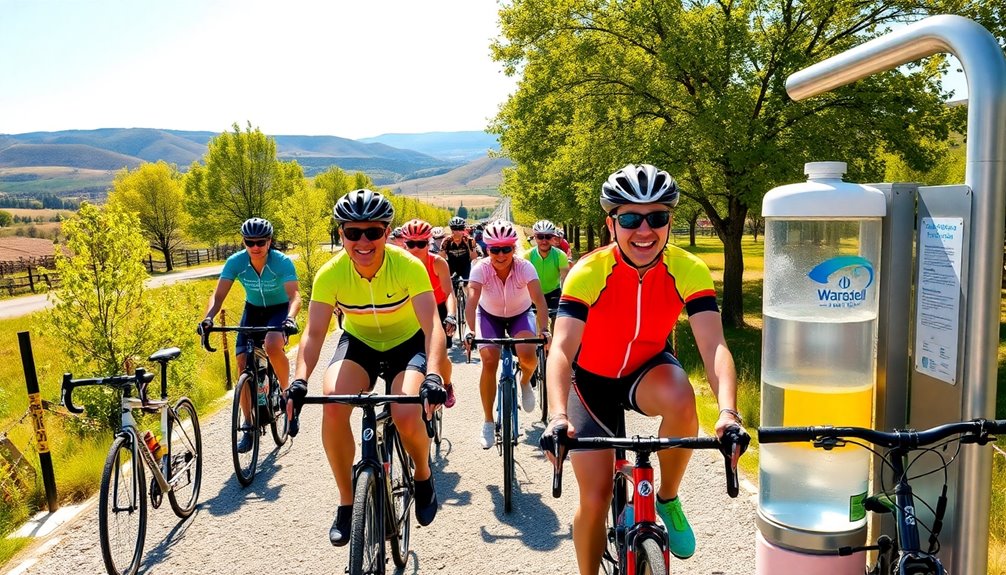
As you embark on your cycling journey, it's essential to consider various health and fitness factors that can enhance your experience.
Cycling boosts your cardiovascular fitness, reduces the risk of heart diseases, and promotes muscle development across your entire body. It's a low-impact activity, protecting your joints while helping with weight management and stress reduction.
To maximize your performance, focus on a balanced diet rich in carbohydrates, proteins, and fats. Stay hydrated during rides and consider in-ride fueling to maintain energy levels.
Incorporate base training and interval workouts to build endurance and strength. Lastly, consistency is key—regular cycling not only improves fitness but also keeps you motivated.
Enjoy the ride and celebrate your progress!
Enhancing Cultural and Environmental Experiences
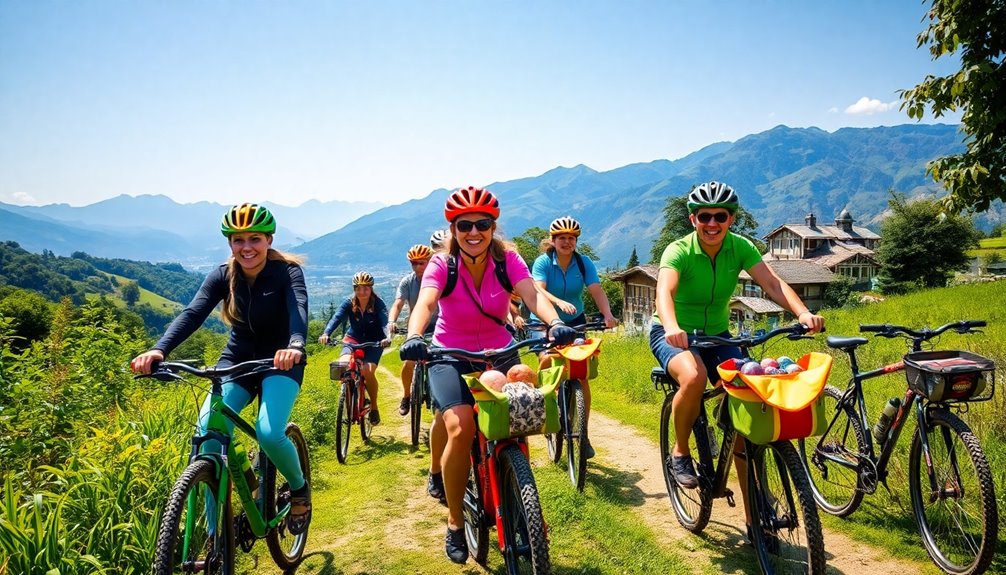
Cycling isn't just about the physical journey; it's also a gateway to enriching cultural and environmental experiences. By pedaling through local communities, you can discover hidden gems and engage with residents, creating genuine connections. Supporting local businesses through homestays and trying regional cuisines enhances your cultural immersion.
Guided tours offer valuable insights into the area's history and heritage, making your experience even more authentic.
From a sustainability perspective, cycling minimizes your carbon footprint and aligns with eco-friendly travel. You'll explore nature-rich landscapes at your own pace, fostering a deeper connection with the environment.
As you ride, you contribute to the development of cycling infrastructure, promoting safer, greener tourism for future travelers. Embrace these experiences for a fulfilling cycling adventure!
Frequently Asked Questions
What Should I Pack for a Multi-Day Cycle Tour?
When packing for a multi-day cycle tour, make sure you include waterproof panniers for your gear, a mini bike pump, and a patch kit with spare inner tubes.
Don't forget comfortable bike shorts and quick-dry jerseys. Bring along cycling gloves, arm warmers, and rain gear, too.
Off the bike, pack casual clothes, toiletries, and a first aid kit.
Lastly, keep your smartphone and GPS handy for navigation.
How Do I Choose the Right Bike for Touring?
"Choose wisely, or you'll pay twice." When selecting a bike for touring, consider your terrain and load.
Endurance bikes offer comfort for long rides, while gravel bikes handle mixed surfaces. If you need to carry heavy gear, touring bikes are your best bet.
Look for low gearing, a sturdy frame, and wide tyre clearance. Don't forget ergonomic features for comfort, and ensure the bike's durable for those long journeys ahead.
What Are Common Mistakes Beginners Make When Cycle Touring?
When you start cycle touring, you're likely to make some common mistakes. You might overlook essential research on your route, leading to unexpected challenges.
Not maintaining your bike can result in breakdowns, while poor itinerary planning can create stress.
Underestimating your physical conditioning may leave you exhausted. Additionally, if you don't budget properly, unexpected expenses can cause financial strain.
Being aware of these pitfalls helps you enjoy a smoother, more fulfilling cycling experience.
How Can I Stay Motivated During Long Rides?
To stay motivated during long rides, you've got to find what works for you. Set clear long-term goals but break them into smaller, achievable ones.
Reflect on past cycling achievements to fuel your drive. Incorporate variety in your training to keep boredom at bay, and don't forget about social support—join a cycling group!
Lastly, celebrate your milestones; it'll remind you of how far you've come and keep your spirits high.
What Should I Do if I Get Lost While Cycling?
If you get lost while cycling, don't panic. First, stop and assess your surroundings.
Check your GPS or map for your last known location. If your device isn't working, look for local signage or recognizable landmarks to guide you.
Asking locals for directions can also be helpful. If you still can't find your way, retrace your route or consider using navigation apps when you're back on track.
Stay calm and focused!
Conclusion
In conclusion, cycle tourism opens up a world of adventure, and with the right preparation, you can tackle any challenge. Take Sarah, for example—a beginner who joined a local guided tour. She discovered breathtaking landscapes and made lifelong friends while learning essential cycling skills. By planning your route, budgeting wisely, and investing in the right gear, you'll not only build confidence but also create unforgettable memories that enhance your experience on two wheels. Happy cycling!
